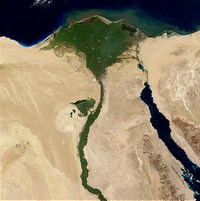Ethiopia’s construction of the Grand Renaissance Dam on the Blue Nile River is creating serious tension among Egypt, Sudan and Ethiopia. There is a fear in Egypt that the large storage capability of the dam will put control of valuable Nile water in the hands of upstream Ethiopia. Egyptian leaders have regularly issued threats to deter Ethiopia from completing the project, without much success. Meanwhile, Sudan, which has had a water-sharing agreement with Egypt on the Nile since 1959, has sided with Ethiopia, heightening uncertainty in Cairo over the future of Nile water sharing.
The Renaissance Dam project has been on the drawing board since the 1960s, but only in March 2011 did Ethiopia officially declare its intention to carry out the construction. The $4.8 billion hydropower project, located in northwestern Ethiopia near the Sudanese border, is designed to have an installed capacity of 5,250 megawatts. The Nile River basin is shared among 10 riparian countries, but the issue of the Grand Renaissance Dam on the Blue Nile in particular directly involves Egypt, Sudan and Ethiopia.
The current distribution of the Nile’s waters is laid out in the 1959 Nile Agreement between the two downstream riparian states Egypt and Sudan, with their annual allotment set at 55.5 billion cubic meters and 18.5 billion cubic meters respectively. However, Ethiopia refuses to acknowledge this agreement, arguing that since most of the river flow originates in its territory, it is entitled to an equitable and reasonable share. Yet despite its high water-development potential, for a long time Ethiopia lacked the political stability and technical and financial means to develop its water systems. Ethiopia’s past efforts were also blocked by Egypt, which continuously campaigned to persuade international creditors and donors not to finance Ethiopian projects.

